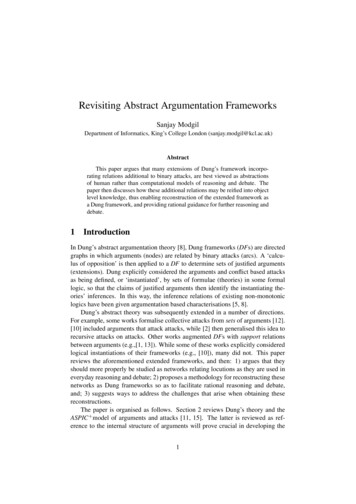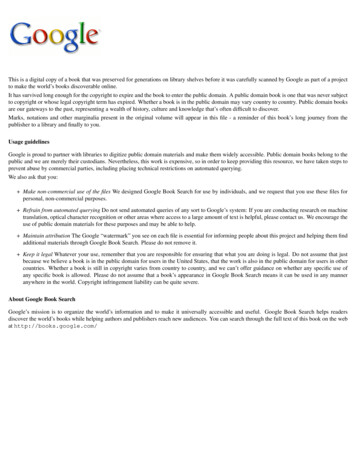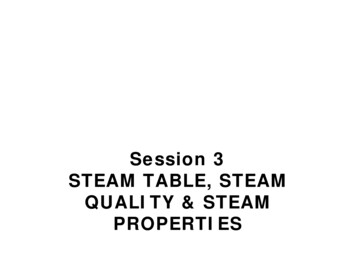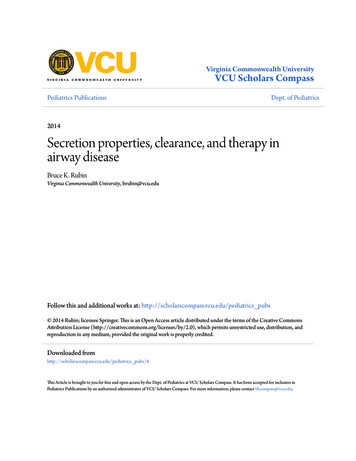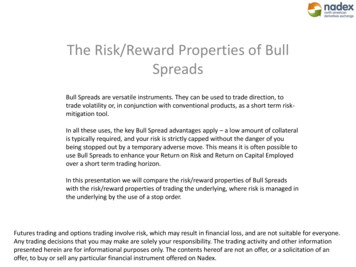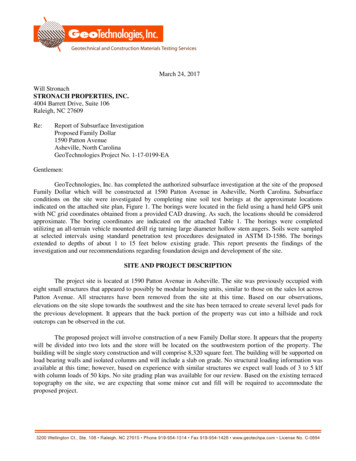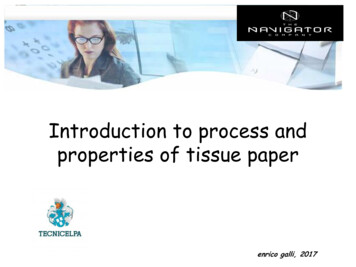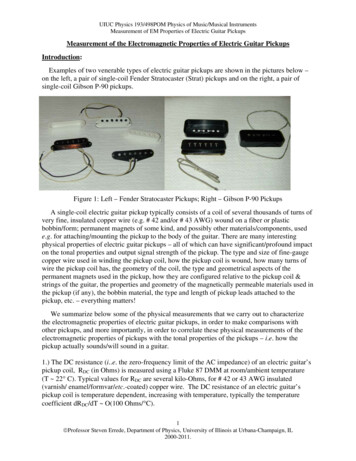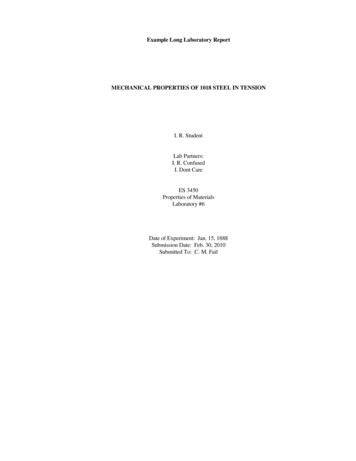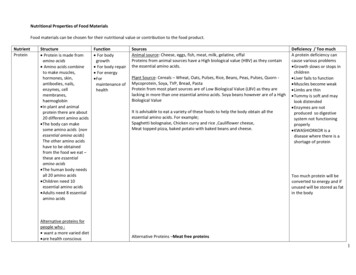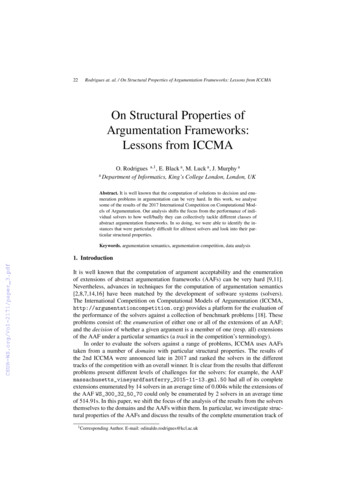
Transcription
22Rodrigues at. al. / On Structural Properties of Argumentation Frameworks: Lessons from ICCMAOn Structural Properties ofArgumentation Frameworks:Lessons from ICCMAO. Rodrigues a,1 , E. Black a , M. Luck a , J. Murphy aof Informatics, King’s College London, London, UKa DepartmentAbstract. It is well known that the computation of solutions to decision and enumeration problems in argumentation can be very hard. In this work, we analysesome of the results of the 2017 International Competition on Computational Models of Argumentation. Our analysis shifts the focus from the performance of individual solvers to how well/badly they can collectively tackle different classes ofabstract argumentation frameworks. In so doing, we were able to identify the instances that were particularly difficult for all/most solvers and look into their particular structural properties.Keywords. argumentation semantics, argumentation competition, data analysis1. IntroductionIt is well known that the computation of argument acceptability and the enumerationof extensions of abstract argumentation frameworks (AAFs) can be very hard [9,11].Nevertheless, advances in techniques for the computation of argumentation semantics[2,8,7,14,16] have been matched by the development of software systems (solvers).The International Competition on Computational Models of Argumentation (ICCMA,http://argumentationcompetition.org) provides a platform for the evaluation ofthe performance of the solvers against a collection of benchmark problems [18]. Theseproblems consist of: the enumeration of either one or all of the extensions of an AAF;and the decision of whether a given argument is a member of one (resp. all) extensionsof the AAF under a particular semantics (a track in the competition’s terminology).In order to evaluate the solvers against a range of problems, ICCMA uses AAFstaken from a number of domains with particular structural properties. The results ofthe 2nd ICCMA were announced late in 2017 and ranked the solvers in the differenttracks of the competition with an overall winner. It is clear from the results that differentproblems present different levels of challenges for the solvers: for example, the AAFmassachusetts vineyardfastferry 2015-11-13.gml.50 had all of its completeextensions enumerated by 14 solvers in an average time of 0.004s while the extensions ofthe AAF WS 300 32 50 70 could only be enumerated by 2 solvers in an average timeof 514.91s. In this paper, we shift the focus of the analysis of the results from the solversthemselves to the domains and the AAFs within them. In particular, we investigate structural properties of the AAFs and discuss the results of the complete enumeration track of1 CorrespondingAuthor. E-mail: odinaldo.rodrigues@kcl.ac.uk
Rodrigues at. al. / On Structural Properties of Argumentation Frameworks: Lessons from ICCMA23the 2nd ICCMA, taking each individual domain into account. Using this information, weaim to provide answers to the following questions: 1) In which domains are the AAFseasier or more difficult to solve? 2) Are there any domains that are beyond the currentcapabilities of all solvers? 3) Is there any correlation between some structural propertiesof an AAF and the ability and speed of the solvers to solve it?Although our analysis is restricted to the complete enumeration track, it reveals somevery interesting patterns in the results. Nearly 23% of all AAFs could not be enumeratedby any solver. In the domain SemBuster, 15 out of the 16 AAFs (93.75%) could not beenumerated at all. The next most challenging domains were Planning2AF, Traffic andBarabasi-Albert, in this order. At the other end of the spectrum, the domains SccGenerator and GroundedGenerator were the easiest to tackle, having only a small proportion ofAAFs whose extensions could not be enumerated by all solvers. These results not onlyconfirm the initial findings in [3] about the sensitivity of argumentation tools to particulargraph models, but also provide a proxy for the complexity of the models in general. Inaddition, our analysis seeks characteristics in the structure of the AAFs likely to makethem more challenging.The rest of the paper is organised as follows. In Section 2, we describe the methodology we used in the evaluation of the results. This is followed in Section 3 by an analysis of the results by domain. In Section 4, we discuss the domains whose extensionswere particularly hard to enumerate, and analyse their structural properties. In Section 5,we suggest an indicator that attempts to predict the enumeration complexity of an AAFbased on its structural properties. In Section 6, we conclude pointing out some directionsfor future work.2. MethodologyIt is worth beginning by summarising how the competition was organised, the results ofthe benchmarking available, and how we used it in the analysis. The competition wasdivided into eight main tracks, one for each of the grounded, complete, preferred, stable,semi-stable, stage and ideal semantics, plus a special track called “Dung’s Triathlon”requiring solvers to enumerate all extensions of all standard Dung-semantics (the firstfour aforementioned) [1,10]. A public call was made for submission of benchmarkproblems (i.e., AAFs) and 11 different domains were selected. For space limitations,we cannot describe each individual domain, but they are listed in Table 3. For moredetails please check selection iccma2017.pdf.In total 350 AAFs were used in the complete enumeration track. Table 3 lists thedomains, the number of AAFs taken from each domain, and an “identifier” that can beused to identify the domain of an AAF in this track. For example, the string “BA” canbe used to identify that the AAF BA 80 80 2 belongs to the Barabasi-Albert domain;the string “gml” can be used to infer that the AAF arlington va 2016-01.gml.20belongs to the Traffic domain; and so forth.Although the competition also included the partial enumeration of extensions as wellas skeptical and credulous decision problems in the seven semantics mentioned above, inorder to keep our analysis focussed and succinct, we have restricted it to the enumerationof all extensions of the complete semantics (i.e., the EE-CO track, in ICCMA’s terminology). Each solver was awarded a score for the enumeration of all complete extensions of
24Rodrigues at. al. / On Structural Properties of Argumentation Frameworks: Lessons from ICCMASolverTotal ABA Adm BA ER GG PL Sem SCC ST Tra WSpyglaf2383213 26 30 24 18129 21 20argmat-dvisat221327 21 27 24 18029 21 15argmat-mpg198327 27 30 24 18127 5 21cegartix1893110 11 25 24 7029 206argmat-sat187327 8 27 24 7029 216ArgSemSAT1823212 7 25 24 6029 195conarg1822113 18 35 21 15112 -8 18heureka1783212 22 30 24 18112 3 20CoQuiAAS1743212 2 25 24 4029 185goDIAMOND 17132-5 3 33 18 5029 215ArgTools157329 10 32 23 6119 85EqArgSolver124327 8 8 24 5028 26argmat-clpb2070 5 01 010 05gg-sts-304 -16065 8 16 -102 -9 0 15 21 -23Table 1. Total scores of all solvers in each domain for the EE-CO track.242762626233642330124127an AAF within the time limit of 600s. The score 1 was awarded for delivering the correct and complete set of extensions of the AAF within 600s; the score -5 was given fordelivering an incorrect extension of the AAF within 600s; and the score 0 was given otherwise (this included results delivered after 600s; the abnormal termination of a solver;and the delivery of an incomplete set of extensions). The total scores by domain for theEE-CO track are shown in Table 1. The results of all problem instances for all solvers areavailable at tml.Using the above available data, we undertook a number of calculations to obtain theaverage enumeration time per AAF, the number of solvers successfully enumerating allextensions within 600s, and several other statistics grouping AAFs by domain. We alsoinvestigated several structural properties of the AAFs, such as their number of argumentsand attacks, how many strongly connected components (SCCs) they had, the density ofattacks of the AAF, etc., by analysing all AAFs ourselves.Since all enumerations completed after 600s were awarded the score 0 regardless ofwhether they were correct or not, in the analysis of the average execution time and thenumber of solvers successfully completing an enumeration, we only considered thoseresults whose scores were 1. We also examined instances that were not successfullycompleted by any solver in the time allowed, since they may point to structural propertiesof interest.In Section 3, we consider the results from the perspective of each individual domain,but first describe some adjustments we made to the results to make our analysis clear.Anomalies in the ResultsDomain SemBuster. The AAFs in the SemBuster domain were proposed by Caminadaand Verheij [6,5]. Their set of arguments is divided into three partitions A, B and C, eachwith a given cardinality k, arranged as in the picture below on the left.
Rodrigues at. al. / On Structural Properties of Argumentation Frameworks: Lessons from ICCMAa1b1c1a2.b2.c2.akbkck25For a given value of k, the AAF in this domain isunique and has exactly n 3k arguments. Using the SCCrecursive schema [2], these arguments can be arranged ink 1 layers: the top layer with bk and ck ; followed by ak ,bk 1 and ck 1 ; and so forth until the last layer with a1alone. The pattern of attacks is also very regular, so wecan easily count them as follows.Proposition 1. An AAF in the SemBuster domain with 3k arguments has k2 3k attacks.Proof. It is easy to see that for every i 1 and every j i, every bi argument attacksevery a j and b j argument. Therefore, for each row 1 i k, we have 2 (i 1) attacks. Summing them all up gives us double the sum of the numbers in the sequence1, 2, . . . , k 1. Furthermore, within each row ai , bi , ci there are exactly 4 attacks. This(k 1) k 4k k2 3k.gives us # attacks 2 ( k 1i 1 i) 4k 2 2Thus, for k 20, we have an AAF with 60 arguments and 202 60 460 attacksarranged in 21 layers. Some properties of the AAFs in this domain are given in Table 2.It was claimed in [6] that these AAFs would have k 1 complete extensions, but infact, they have a much larger number t of complete extensions: t 2k k.Proposition 2. A SemBuster AAF with 3k arguments has 2k k complete extensions.Proof. Note that no extension can contain an argument from the A partition, so all complete labellings label all ai arguments either out or und. The number 2k k comes fromthe following observations: i) There are exactly k complete labellings with exactly oneB argument labelled in: for each bi that is labelled in, all arguments b j such that j 6 imust be labelled out, and, consequently all corresponding arguments c j must be labelledin. In addition, for all j i, a j is labelled out, and for all j i, a j is labelled und; andii) The remaining 2k labellings give all complete extensions that are subsets EC of the Cpartition (obviously, without a B element).They can be constructed as follows:out, if ci ECin, if ci ECλ (ai ) und, for i k λ (bi ) λ (ci ) und, otherwiseund, otherwiseNote that case ii) in the proof above includes the empty extension (when EC andall arguments are labelled und). Incidentally, this means that not every complete labellingis also a preferred labelling in this domain (cf. [6]). In particular, all non-maximal subsetsof C in case ii) above are not preferred.AAFs of this type pose a challenge beyond the actual computation of the completelabellings since the number of complete extensions grows exponentially to the number ofarguments. For example, the smallest SemBuster AAF in this domain, sembuster 60,has only 60 arguments but 1, 048, 596 extensions. Thus, the amount of data generatedin the solutions becomes problematic and, for a sufficiently large value of n, it cannotbe enumerated in any reasonable time. In fact, this is not the only domain where a relatively low number of arguments generates a very large number of extensions. The number of complete extensions of the so-called bi-directed cycle graphs is even larger [16].Whereas a SemBuster framework with 36 arguments only has 4, 108 complete extensions, a bi-directed cycle graph with 36 arguments has 7, 095, 675.The results of the competition for the SemBuster domain include the ones listedin Table 2 (recall, all results presented here are for the EE-CO track). The solver
26Rodrigues at. al. / On Structural Properties of Argumentation Frameworks: Lessons from ICCMAAAFsembuster 60sembuster 150sembuster 300sembuster 600sembuster 900sembuster 1200sembuster 1500sembuster 1800sembuster 2400sembuster 3000sembuster 3600sembuster 4200sembuster 4800sembuster 5400sembuster 6000sembuster 7500SolversAwardedScore 1argmat-clpb/mpg6046040221 ArgTools, conargheureka, 009090060023011200 16120080024011500 25150010002501gg-sts1800 36180012002601gg-sts2400 64240016002801gg-sts3000 1003000200021001gg-sts3600 1443600240021201gg-sts4200 1964200280021401gg-sts4800 2564800320021601gg-sts5400 3245400360021801gg-sts6000 4006000400022001gg-sts7500 6257500500022501Table 2. Details of the AAFs in the SemBuster domain.Args 4730.2932.5133.5833.1233.5227.9129.7732.29-gg-sts was awarded scored 1 for the instances 1500–6000, the smallest of which wassembuster 1500, with 1500 arguments and therefore 2500 500 complete extensions.Clearly, these cannot have been computed and enumerated, so these results cannot becorrect. We have contacted the organisers of the competition who, at the time of writing,are investigating. For the purposes of our analysis, we disregarded the results providedby gg-sts in the above instances.Other results not fully verified. A number of other instances outside the SemBusterdomain were also enumerated by only one solver. At the time of writing, our understanding is that although there was some scrutiny of the results provided by a single solver,they were not fully verified. Thus, there may well be other instances where a score 1was incorrectly awarded. In our analysis, we only modified the results above since theyare mathematically impossible in the time given. This means that the analysis presentedin Section 4.2 may need to be adjusted should the results change. However, the overallmethodology we have employed is justified with the data given. For a discussion on thedifficulties of verifying the competition results, please see Section 6.3. Challenging DomainsThe EE-CO track evaluated the overall performance of the solvers over the whole set of350 AAFs. It is interesting to look at how these results fare within each individual domain. Table 1 shows how each solver performed in each domain, with the best resultshighlighted in bold. The overall results are displayed in the column “Total”. The resultswith a have been adjusted as described in Section 2. In the table, the term ABA is usedfor the domain ABA2AF, Adm for the domain AdmBuster, BA for the domain BarabasiAlbert, ER for the domain Erdös-Rényi, GG for the domain GroundedGenerator, PL forthe domain Planning2AF, Sem for the domain SemBuster, SCC for the domain SccGen-
Rodrigues at. al. / On Structural Properties of Argumentation Frameworks: Lessons from ICCMA27erator, ST for the domain StableGenerator, Tra for the domain Traffic, and WS for thedomain Watts-Strogatz.Table 1 shows that every solver obtained the highest score in at least one domain,confirming a similar finding in [4], which analysed a subset of the 1st ICCMA’s solverson a smaller number of domains.2 If we shift focus from solver to domain, we can definea proxy for complexity by examining how the solvers performed overall in each domain.In particular, we consider how many of the domain instances could not be solved by anysolver. Table 3 contains the average execution time of the successful enumerations aswell as the percentage of instances in each domain left unsolved by all solvers (within600s). Four domains had a particularly high proportion of unsolved instances. As expected from our analysis in Section 2, the domain SemBuster had nearly all instances leftunsolved (93.75%). This was followed by the domain Planning2AF, which had 58.13%of its instances left unsolved; followed by the domain Traffic with 43.90% of instances;and then the domain Barabasi-Albert with 34.14% of instances left unsolved. Table 3 alsoshows the number of instances solved by at most one solver. In general, the proportionof problems that could be solved by only a few solvers was also very TotalAAFs3213414024431630304140350Unsolved (%) 1 solver Avg 93.86s41.29s146.73s7810457.50sTable 3. Distribution of “hard” problems by domain.Figure 1 generalises this further. It provides an overview of the percentage of theAAFs left unsolved by a given number of solvers by domain. The x-axis in the plotrepresents the number of solvers that were unable to solve problems in a domain andthe y-axis represents the percentage of problems left unsolved by those solvers. So forexample, for x 16, y gives the percentage of problems left unsolved by 16 solvers (i.e.,all) in each domain (compare this with Table 3).At the other end of the spectrum, the domains GroundedGenerator, SccGeneratorand ABA2AF were the easiest to tackle, with only a small proportion of AAFs left unsolved by a few solvers.4. Challenging AAFsThe extensions of 78 out of the 350 AAFs (22.28%) in the EE-CO track could not befully enumerated within 600s. In addition, the full enumeration of the extensions of 26other AAFs could only be completed by a single solver. For the purposes of this analysis,2 Thedomains considered in [4] were Barabasi-Albert, Erdös-Rényi, Kleinberg [13], and plain tree-graphs.
28Rodrigues at. al. / On Structural Properties of Argumentation Frameworks: Lessons from ICCMA% of graphs by domain not solved by x solvers100%90%Percentage not 10%0%16151413121110987By number of solvers654321Figure 1. Percentage of instances left unsolved by number of solvers and domainwe refer to these particularly challenging 104 AAFs as the “hard” AAFs. Together theyrepresent 29.71% of the total number of AAFs in the EE-CO track.Our objective in the identification of the hard AAFs is to shed some light into specific structural properties that may make them difficult to solve. In addition, in futurework this may help to draw some correlation between the techniques that were used bythe solvers managing to solve them and the AAFs’ structural properties. The tables inAppendix A give further structural details about the challenging AAFs in some of thehardest domains.4.1. AAFs Not Solvable By Any SolverWe have already concluded from the anomalies of the SemBuster domain presented inSection 2, that the difficulty in the enumeration of the complete extensions of an AAF canarise not only because of the complexity of the attack configuration of the framework, butalso from the number of extensions itself. Besides SemBuster, the domain Planning2AFwas clearly the hardest to tackle, containing 32.05% of all unsolvable AAFs (58.14% ofthe AAFs in the domain); followed by the Traffic domain with 23.07% of all unsolvableAAFs (43.90% of the domain), and then by the Barabasi-Albert domain with 17.94% ofall unsolvable AAFs (34.15% of the domain). We discuss some structural pr
of extensions of abstract argumentation frameworks (AAFs) can be very hard [9,11]. Nevertheless, advances in techniques for the computation of argumentation semantics [2,8,7,14,16] have been
